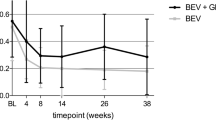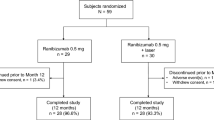Abstract
Purpose
To compare the effects of subthreshold grid laser treatment (SGLT) and intravitreal bevacizumab injection (IVBI) for the treatment of macular edema (ME) secondary to branch retinal vein occlusion (BRVO) recurring after conventional grid laser photocoagulation.
Methods
Thirty-five eyes were considered in this prospective, randomised, interventional study and treated with micropulse diode laser (SGLT subgroup) or IVBI (IVBI subgroup). SGLT was administered once, whereas IVBI (1.25 mg) was given at baseline and then on a pro re nata regimen according to ME presence on optical coherence tomography (OCT), performed at monthly examinations over a 12-month follow-up. Primary outcome measures were the mean BCVA changes over the follow-up and the decrease in mean central foveal thickness (CFT) on optical coherence tomography (OCT). Secondary outcomes included the proportion of eyes that gained at least 15 letters (approximately three lines) at the 12-month examination.
Results
Eighteen and 17 patients were assigned to SGLT and IVBI subgroups, respectively. At baseline, the subgroups were similar with regard to mean ME duration, BCVA, and CFT. At month 12, mean CFT significantly improved from 484 μm to 271 μm in the IVBI subgroup, whereas it was unchanged in the SGLT subgroup. Mean BCVA changed from 0.92 ± 0.3 (LogMAR) to 0.99 ± 0.2 in the SGLT subgroup; in the IVBI subgroup, mean BCVA showed a statistically significant improvement from 0.94 ± 0.3 to 0.72 ± 0.2. Ten patients in the IVBI subgroup (58 %) and no patient in the SGLT subgroup gained at least three lines.
Conclusion
At the 1-year follow-up, IVBI provided a significant functional and anatomical improvement, whereas SGLT failed to demonstrate any beneficial effects. IVBI might be a useful approach in the treatment of recurrent ME secondary to BRVO already treated with conventional grid laser photocoagulation.
UMIN registry, number UMIN000005014, URL: http://www.umin.ac.jp/ctr/index.htm


Similar content being viewed by others
References
Pielen A, Feltgen N, Isserstedt C et al (2013) Efficacy and safety of intravitreal therapy in macular edema due to branch and central retinal vein occlusion: A systematic review. PLoS One 8:e78538
The Branch Vein Occlusion Study Group (1984) Argon laser photocoagulation for macular edema in branch vein occlusion. Am J Ophthalmol 98:271–282
Schatz H, Madeira D, McDonald HR et al (1991) Progressive enlargement of laser scars following grid laser photocoagulation for diffuse diabetic macular edema. Arch Ophthalmol 109:1549–1551
Morgan CM, Schatz H (1989) Atrophic creep of the retinal pigment epithelium after focal macular photocoagulation. Ophthalmology 96:96–103
Early Treatment Diabetic Retinopathy Study Research Group (1995) Focal photocoagulation treatment of diabetic macular edema. Relationship of treatment effect to fluorescein angiographic and other retinal characteristics at baseline: ETDRS report no 19. Arch Ophthalmol 113:1144–1155
Parodi MB, Spasse S, Iacono P et al (2006) Subthreshold grid laser treatment of macular edema secondary to branch retinal vein occlusion with micropulse infrared (810 nanometer) diode laser. Ophthalmology 113:2237–2242
Parodi MB, Iacono P, Ravalico G (2008) Intravitreal triamcinolone acetonide combined with subthreshold grid laser treatment for macular oedema in branch retinal vein occlusion: a pilot study. Br J Ophthalmol 92:1046–1050
Campochiaro PA, Heier JS, Feiner L et al (2010) Ranibizumab for macular edema following branch retinal vein occlusion: six-month primary end point results of a phase III study. Ophthalmology 117:1102–1112
Heier JS, Campochiaro PA, Yau L et al (2012) Ranibizumab for macular edema due to retinal vein occlusions: long-term follow-up in the HORIZON trial. Ophthalmology 119:802–809
Brown DM, Campochiaro PA, Bhisitkul RB et al (2011) Sustained benefits from ranibizumab for macular edema following branch retinal vein occlusion: 12-month outcomes of a phase III study. Ophthalmology 118:1594–1602
Tan MH, McAllister IL, Gillies ME et al (2013) Randomized Controlled Trial of Intravitreal Ranibizumab Versus Standard Grid Laser for Macular Edema Following Branch Retinal Vein Occlusion. Am J Ophthalmol 157:237–247
Haller JA, Bandello F, Belfort R Jr, Blumenkranz MS et al (2010) Randomised, sham-controlled trial of dexamethasone intravitreal implant in patients with macular edema due to retinal vein occlusion. Ophthalmology 117:1134–1146.e3
Scott IU, Ip MS, VanVeldhuisen PC, Oden NL et al (2009) A randomized trial comparing the efficacy and safety of intravitreal triamcinolone with standard care to treat vision loss associated with macular edema secondary to branch retinal vein occlusion: the Standard Care vs Corticosteroid for Retinal Vein Occlusion (SCORE) study report 5. Arch Ophthalmol 127:1115–1128
Hikichi T, Higuchi M, Matsushita T et al (2013) Two-year outcomes of intravitreal bevacizumab therapy for macular oedema secondary to branch retinal vein occlusion. Br J Ophthalmol 98:195–199
Pielen A, Mirshahi A, Feltgen N, Lorenz K, et al. (2014) Ranibizumab for Branch Retinal Vein Occlusion Associated Macular Edema Study (RABAMES): Six-month results of a prospective randomized clinical trial. Acta Ophthalmol doi:10.1111/aos.12488. [Epub ahead of print]
Tan MH, McAllister IL, Gillies ME, Verma N et al (2014) Randomized controller trial of intravitreal ranibizumab versus standard grid laser for macular edema following branch retinal vein occlusion. Am J Ophthalmol 157:237–247
Kreutzer TC, Alge CS, Wolf AH, Kook D et al (2008) Intravitreal bevacizumab for the treatment of macular oedema secondary to branch retinal vein occlusion. Br J Ophthalmol 92:351–355
Douglas G. Altman. (1991) Sample size. In: Practical Statistics for Medical Research, 1st edn. Chapman &Hall/CRC, London, pp: 440–476
Sivaprasad S, Elagouz M, McHugh D, Shona O, Dorin G (2010) Micropulsed diode laser therapy: evolution and clinical applications. Surv Ophthalmol 55:516–530
Conflict of Interest Statement
All authors contributing to the present paper certify that they have no financial interest or non-financial interest in the subject matter or materials discussed in this manuscript.
Author information
Authors and Affiliations
Corresponding author
Additional information
The authors have no proprietary/financial interest in any of the products mentioned in the study.
Rights and permissions
About this article
Cite this article
Parodi, M.B., Iacono, P. & Bandello, F. Subthreshold grid laser versus intravitreal bevacizumab as second-line therapy for macular edema in branch retinal vein occlusion recurring after conventional grid laser treatment. Graefes Arch Clin Exp Ophthalmol 253, 1647–1651 (2015). https://doi.org/10.1007/s00417-014-2845-6
Received:
Revised:
Accepted:
Published:
Issue Date:
DOI: https://doi.org/10.1007/s00417-014-2845-6




